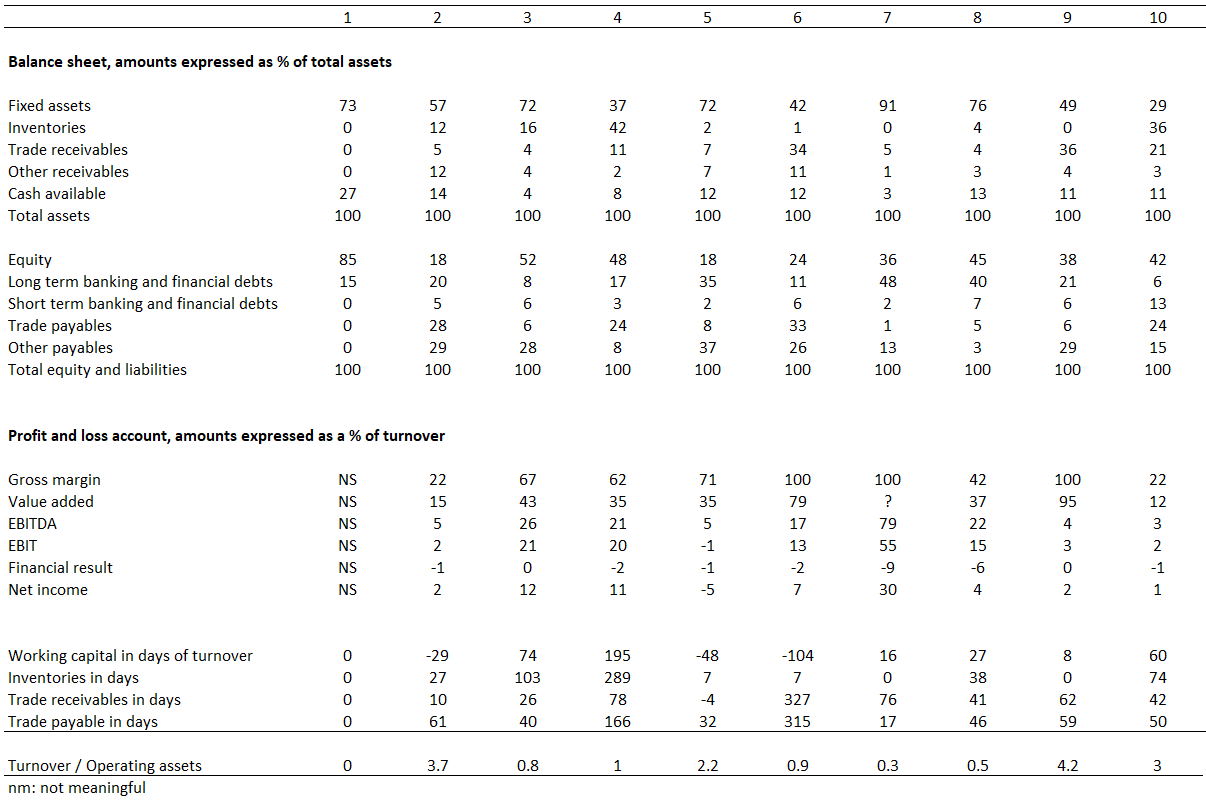Who is who?
Just to ensure that your neurons don’t all fall asleep, we thought that we’d test you with a little detective work, worthy of the best financial analysts and also beginners. Haven’t we said before[1] that “Financial analysts are detectives". Who is who? invites you to find out which economic sectors are hiding behind the series of figures that follows.
We’re looking for:
A general retailer,
A luxury group,
An advertising agency,
A cement maker,
A trader in steel products,
A temporary employment group,
A satellite operator,
An airline company,
A Cognac producer,
A holding company.
There are two ways in which you can go about working out the answers. Either you start off with the table of figures and identify on each line the figures that are the lowest or the highest and guess who they belong to. Or you can start off with the list of companies and think about the economic and financial figures of each of them, then identify their figures in the table. We feel that this second method is the most worthwhile method as it makes you think abstractly about the financial characteristics of a company before studying it, which makes it possible to detect anomalies more easily.
Solution:
What is a holding company if not a company that does not have its own operating activity and accordingly does not have any working capital? So it’s number 1.
What is a producer of Cognac if not a brand (which will only be included in intangible assets if it has been acquired[2]), cellars and inventories, because it takes 7 years to make a Cognac. So its number 4. Remember that since inventories are valued at their cost price and not their sale price, they represent 289 days of sales and would represent a lot more in days of cost price.
What is a satellite operator if not a company that rents a satellite in orbit to which waves are transmitted which are then retransmitted back to earth? In other words, a company with a very high level of fixed assets, few inventories, probably a very high EBITDA margin (operating costs are low). So it’s number 7.
What is an airline company if not a business where customers pay, generally in advance, with few inventories and a lot of fixed assets? So it’s number 5.
What is a luxury business if not an enterprise with a high EBIT (when things are going well), sales generally made to direct customers, so with low levels of trade receivables? It’s number 3. The large number of fixed assets is explained by the purchase of a large number of brands.
What is a general retailer if not a company with negative working capital - there is quick inventory turnover, customers pay cash or by credit card at the end of the month and margins are low? It’s number 2.
What is a trader in steel products if not a retailer like the general retailer above, but which has high levels of inventories with a much slower rate of turnover? It’s number 10.
What is an advertising agency is not, from a financial point of view, a company that collects funds from its customers, the advertisers, and which passes them on some time later to the media that broadcast the messages that it has designed? It even plays a role of settlement agency or bank – the Saatchi brothers at the height of their glory were seriously considering buying the Midlands Bank. So it’s number 6.
What is a temporary employment group if not a company without inventories, with no purchases (so with a gross margin of 100%) and low margins as it does not have much invested capital. So it’s number 9.
As for a cement group, it’s a company with a lot of fixed assets (can you remember the last time you saw a cement works?), so probably with a substantial amount of debt and low sales turnover compared with capital employed. A bag of cement isn’t worth much. You can get a 35kg bag of cement for less than €10 – for this price you wouldn’t even be able to buy 2 sq cm of a Louis Vuitton bag! So it’s number 8, which is also the last on our list.

